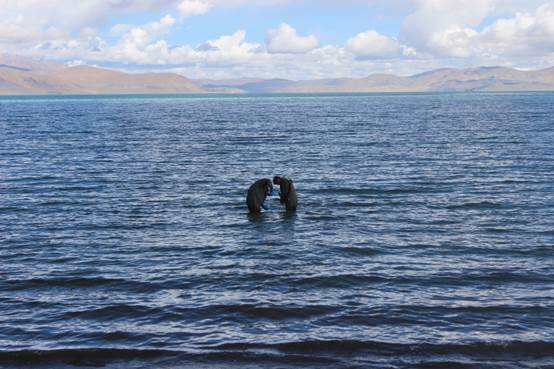| News |
| Latest news | |
| Int’l Cooperation activities | |
| Events & Announcement | |
| Recent Activities |
| Location: Home>News>Recent Activities |
| Climate Change: How ENSO Affects the Tibetan Plateau |
El
Pung Co, Tibet (Photograph by LEI Yanbin) The 2015/2016 ENSO events, one of the three strongest on record, was so huge that it affected weather all over the world. Earlier studies revealed the significant impact of ENSO on the East Asian climate, but few explored its possible impact on the Tibetan Plateau. This drove the researchers to raise a key question: does the strong event have a role to play in what happens on the Tibetan Plateau? Since 2013, the scientists have carried out extensive fieldwork to monitor lake level changes on the central Tibetan Plateau and captured the whole process of lake level changes during this event. It was found that lakes on the central Tibetan Plateau experienced significant shrinkage due to a dramatic decrease in precipitation in 2015. In the following 2016 and 2017, most lakes over the Tibetan Plateau expanded at unusually high speed. Similar but weaker lake shrinkage and afterwards lake expansion also occurred during the historical ENSO events. Based on the data and analysis, the team further explored how ENSO can influence the climate of the Tibetan Plateau on a large scale. According to their finding, when an ENSO develops in the summer, a dry zone is formed along the northwestern edge of the Asian monsoon domain. That means that the dry anomalies in the central Tibetan Plateau tends to bridge the dry anomalies over India and the northern China.
Lake level changes on the Central Tibetan Plateau in ENSO developing summers since 1990 This study broadened our perspective on the ENSO-Asian monsoon linkage and may shed light on the prediction of lake level changes on the Tibetan Plateau. (Reported by TIE Xinyu) Dr. LEI Yanbin is the first and corresponding author of the study Extreme lake level changes on the Tibetan Plateau associated with the 2015/2016 El DOI: https://agupubs.onlinelibrary.wiley.com/doi/10.1029/2019GL081946 |
 –Southern Oscillation (ENSO for short) may explain why the lakes over the Tibetan Plateau dramatically shrank and then expanded between 2013 and 2017, according to a latest study by scientists from the Institute of Tibetan Plateau Research, Chinese Academy of Sciences (ITPCAS), the Institute of Atmospheric Physics, Chinese Academy of Sciences (IAPCAS) and the University of Hawaii.
–Southern Oscillation (ENSO for short) may explain why the lakes over the Tibetan Plateau dramatically shrank and then expanded between 2013 and 2017, according to a latest study by scientists from the Institute of Tibetan Plateau Research, Chinese Academy of Sciences (ITPCAS), the Institute of Atmospheric Physics, Chinese Academy of Sciences (IAPCAS) and the University of Hawaii.

 . The research was supported by the Strategic Priority Research Program (PAN-TPE) of the Chinese Academy of Sciences.
. The research was supported by the Strategic Priority Research Program (PAN-TPE) of the Chinese Academy of Sciences.